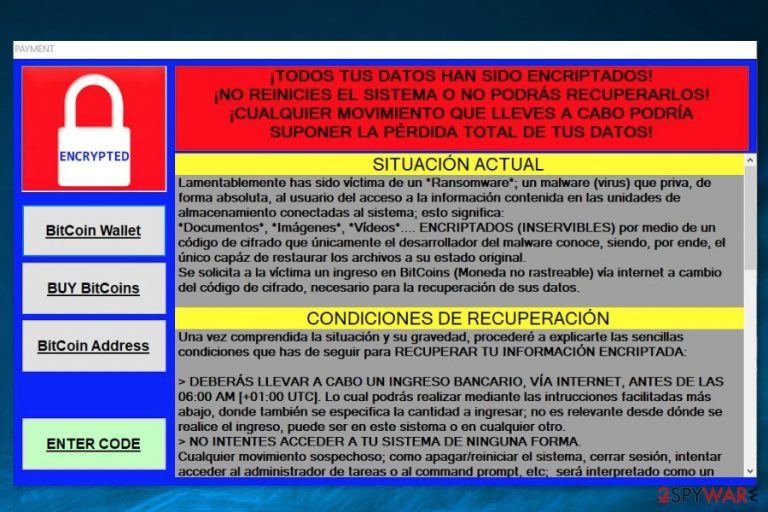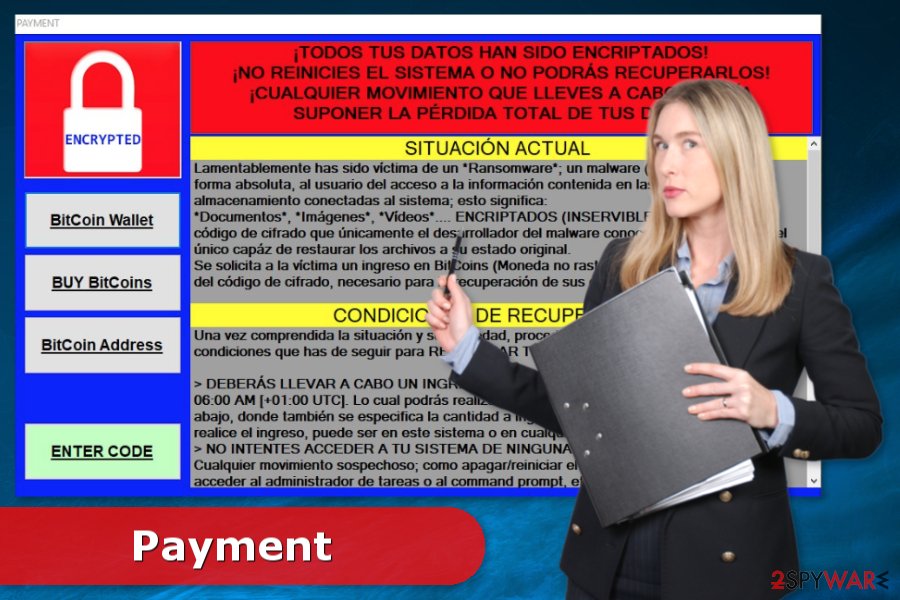Payment ransomware (Simple Removal Guide) - Decryption Steps Included
Payment virus Removal Guide
What is Payment ransomware?
Payment ransomware virus is still in development

Payment ransomware is a debug version of the file-encrypting virus that is designed to attack Spanish[1] computer users. The virus uses AES cryptography to make files on the targeted devices inaccessible. However, at the moment of writing malware does not encrypt data. Though, the situation might change soon; thus, you should be aware of the latest cyber infection.
The crypto-malware is activated from the PAYMENT.exe file which might be delivered via malicious spam emails, bogus download, and many other common ransomware distribution methods. Once it infiltrates the system, it might cause severe changes to the system.
Typically, file-encrypting viruses modify Windows registry in order to boot with system startup. Additionally, ransomware might affect legitimate processes and disable computer’s security. Therefore, after Payment virus attack, the affected device becomes vulnerable, and user’s privacy might be at risk.
However, the most important task of the Payment malware is to encrypt targeted files. According to the ransom note, this malicious program is designed to encode documents, images, videos and similar files using AES cryptography.
Following successful encryption, malware delivers a ransom note where cyber criminals in the Spanish language provide data recovery instructions. Just like other crypto-viruses, this one also demands to make the payment in Bitcoin. Additionally, crooks want to scare victims that other actions instead of making the payment will lead to serious problems.
However, if you ever get infected with this ransomware, you should not listen to threatening talks of the crooks. Payment removal is the only correct way to treat this malicious program. Though, to perform deletion of the virus is nearly impossible without security software.
We do not recommend even trying to remove Payment manually. This may lead to irreparable damage to the system because ransomware-type threats often hide under legitimate names. So, you might be misled by the title and remove the wrong entry. Thus, use FortectIntego or another malware removal tool for the safe elimination.

Safety tips for ransomware precautions
Ransomware attack might be a harmful experience. However, no one can feel safe from these cyber threats that become more and more aggressive. Thus, installing reputable security software and creating backups is a must in order to minimize the risk or survive ransomware attack.
However, having an antivirus program installed is not enough to avoid ransomware. You should also:
- Check the information about sender and issue reported in the email before opening the attachment.[2]
- Download programs and updates from the official websites instead of torrents or unknown file-sharing networks.
- Install all available system and software updates.
- Avoid visiting high-risk websites, such as an adult-themed[3] or online casino.
Termination guide of Payment virus
If you ever get infected with ransomware, you should not panic and follow hacker’s instructions. The most important task is Payment removal that is performed with professional malware removal program. We recommend using FortectIntego, Malwarebytes or SpyHunter 5Combo Cleaner. However, you can choose your preferred tool as well.
Additionally, you should reboot to Safe Mode with Networking in order to remove Payment ransomware without any problems. At the end of the article, you will find detailed malware removal guide and data recovery solutions that might help as well.
Getting rid of Payment virus. Follow these steps
Manual removal using Safe Mode
If you have problems with automatic Payment ransomware removal, follow this guide:
Important! →
Manual removal guide might be too complicated for regular computer users. It requires advanced IT knowledge to be performed correctly (if vital system files are removed or damaged, it might result in full Windows compromise), and it also might take hours to complete. Therefore, we highly advise using the automatic method provided above instead.
Step 1. Access Safe Mode with Networking
Manual malware removal should be best performed in the Safe Mode environment.
Windows 7 / Vista / XP
- Click Start > Shutdown > Restart > OK.
- When your computer becomes active, start pressing F8 button (if that does not work, try F2, F12, Del, etc. – it all depends on your motherboard model) multiple times until you see the Advanced Boot Options window.
- Select Safe Mode with Networking from the list.

Windows 10 / Windows 8
- Right-click on Start button and select Settings.

- Scroll down to pick Update & Security.

- On the left side of the window, pick Recovery.
- Now scroll down to find Advanced Startup section.
- Click Restart now.

- Select Troubleshoot.

- Go to Advanced options.

- Select Startup Settings.

- Press Restart.
- Now press 5 or click 5) Enable Safe Mode with Networking.

Step 2. Shut down suspicious processes
Windows Task Manager is a useful tool that shows all the processes running in the background. If malware is running a process, you need to shut it down:
- Press Ctrl + Shift + Esc on your keyboard to open Windows Task Manager.
- Click on More details.

- Scroll down to Background processes section, and look for anything suspicious.
- Right-click and select Open file location.

- Go back to the process, right-click and pick End Task.

- Delete the contents of the malicious folder.
Step 3. Check program Startup
- Press Ctrl + Shift + Esc on your keyboard to open Windows Task Manager.
- Go to Startup tab.
- Right-click on the suspicious program and pick Disable.

Step 4. Delete virus files
Malware-related files can be found in various places within your computer. Here are instructions that could help you find them:
- Type in Disk Cleanup in Windows search and press Enter.

- Select the drive you want to clean (C: is your main drive by default and is likely to be the one that has malicious files in).
- Scroll through the Files to delete list and select the following:
Temporary Internet Files
Downloads
Recycle Bin
Temporary files - Pick Clean up system files.

- You can also look for other malicious files hidden in the following folders (type these entries in Windows Search and press Enter):
%AppData%
%LocalAppData%
%ProgramData%
%WinDir%
After you are finished, reboot the PC in normal mode.
Remove Payment using System Restore
This method helps to disable the virus and run automatic elimination:
-
Step 1: Reboot your computer to Safe Mode with Command Prompt
Windows 7 / Vista / XP- Click Start → Shutdown → Restart → OK.
- When your computer becomes active, start pressing F8 multiple times until you see the Advanced Boot Options window.
-
Select Command Prompt from the list

Windows 10 / Windows 8- Press the Power button at the Windows login screen. Now press and hold Shift, which is on your keyboard, and click Restart..
- Now select Troubleshoot → Advanced options → Startup Settings and finally press Restart.
-
Once your computer becomes active, select Enable Safe Mode with Command Prompt in Startup Settings window.

-
Step 2: Restore your system files and settings
-
Once the Command Prompt window shows up, enter cd restore and click Enter.

-
Now type rstrui.exe and press Enter again..

-
When a new window shows up, click Next and select your restore point that is prior the infiltration of Payment. After doing that, click Next.


-
Now click Yes to start system restore.

-
Once the Command Prompt window shows up, enter cd restore and click Enter.
Bonus: Recover your data
Guide which is presented above is supposed to help you remove Payment from your computer. To recover your encrypted files, we recommend using a detailed guide prepared by 2-spyware.com security experts.If your files are encrypted by Payment, you can use several methods to restore them:
Data Recovery Pro might help to restore corrupted files
Nevertheless, this tool is created to restore corrupted or accidentally deleted files; it might also help after ransomware attack as well.
- Download Data Recovery Pro;
- Follow the steps of Data Recovery Setup and install the program on your computer;
- Launch it and scan your computer for files encrypted by Payment ransomware;
- Restore them.
Try Windows Previous Versions feature
If System Restore feature was enabled before Payment ransomware attack, you can restore individual files by following these steps:
- Find an encrypted file you need to restore and right-click on it;
- Select “Properties” and go to “Previous versions” tab;
- Here, check each of available copies of the file in “Folder versions”. You should select the version you want to recover and click “Restore”.
ShadowExplorer helps if Shadow Volume Copies were not deleted
If shadow copies were not removed after ransomware attack, this tool might help you to restore data:
- Download Shadow Explorer (http://shadowexplorer.com/);
- Follow a Shadow Explorer Setup Wizard and install this application on your computer;
- Launch the program and go through the drop down menu on the top left corner to select the disk of your encrypted data. Check what folders are there;
- Right-click on the folder you want to restore and select “Export”. You can also select where you want it to be stored.
Payment decryptor is not available.
Finally, you should always think about the protection of crypto-ransomwares. In order to protect your computer from Payment and other ransomwares, use a reputable anti-spyware, such as FortectIntego, SpyHunter 5Combo Cleaner or Malwarebytes
How to prevent from getting ransomware
Access your website securely from any location
When you work on the domain, site, blog, or different project that requires constant management, content creation, or coding, you may need to connect to the server and content management service more often. The best solution for creating a tighter network could be a dedicated/fixed IP address.
If you make your IP address static and set to your device, you can connect to the CMS from any location and do not create any additional issues for the server or network manager that needs to monitor connections and activities. VPN software providers like Private Internet Access can help you with such settings and offer the option to control the online reputation and manage projects easily from any part of the world.
Recover files after data-affecting malware attacks
While much of the data can be accidentally deleted due to various reasons, malware is one of the main culprits that can cause loss of pictures, documents, videos, and other important files. More serious malware infections lead to significant data loss when your documents, system files, and images get encrypted. In particular, ransomware is is a type of malware that focuses on such functions, so your files become useless without an ability to access them.
Even though there is little to no possibility to recover after file-locking threats, some applications have features for data recovery in the system. In some cases, Data Recovery Pro can also help to recover at least some portion of your data after data-locking virus infection or general cyber infection.
- ^ Los Virus. Los Virus. Spanish cyber security news.
- ^ Nate Lord. Phishing Attack Prevention: How to Identify & Avoid Phishing Scams. Digital Guardian. Blog about latest cyber security news and trends.
- ^ Jasper Hamill. PornHub users infected with nasty virus spread by cyber crooks. News. Australian news website.







